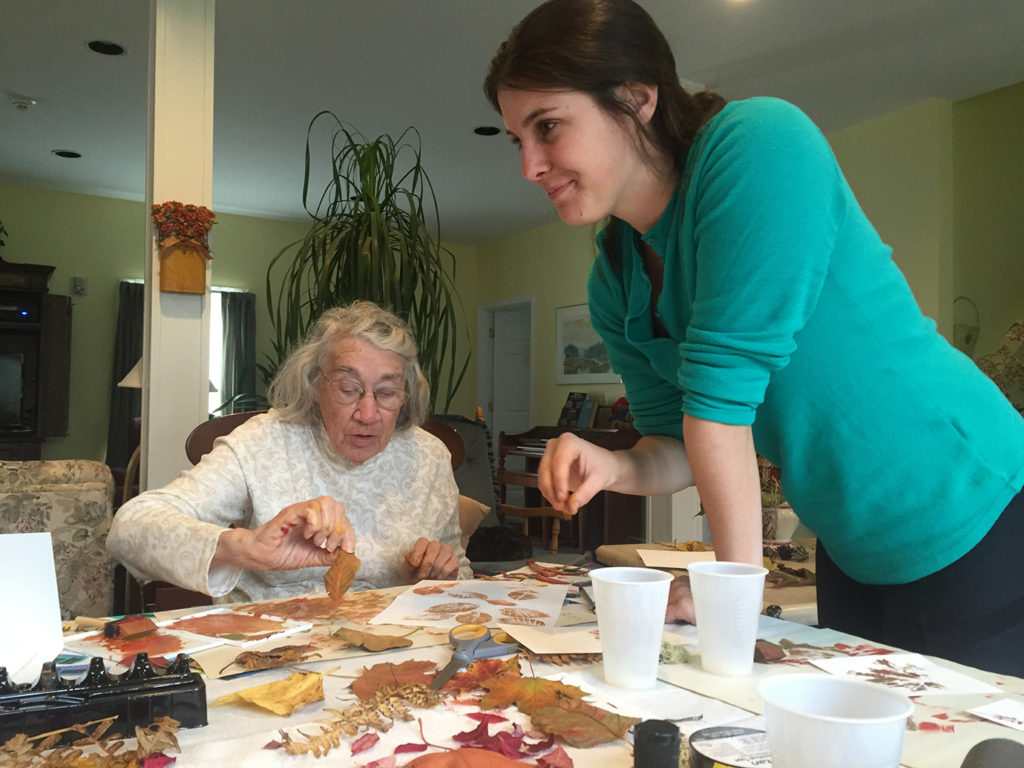Maddey Gates is the eldercare Island Fellow. She has lived and worked on eldercare initatives on Chebeague, North Haven, Swan’s Island, and now Vinalhaven during her fellowship.
Close your eyes. When I say “eldercare,” what comes to your mind? What do you see, smell, and feel when I say “seniors,” “elders,” “nursing home,” or “residential care”?
I am a proud resident of the Ivan Calderwood Homestead – a Level 4 PNMI Residential Care Facility supported by Vinalhaven Eldercare Services. I am 23 years old. I have six roommates, all of whom were over sixty the year I was born. No, I’m not Benjamin Button, but I do receive curious looks when I answer one of the most common questions posed by islanders to newcomers in the community — “Where are you living?”
“Well…” I say, “actually I live up at the Homestead!”
“Oh…up to Eldercare…” they say, usually with sort of a nervous chuckle. “Huh. How’s that?”
There is a stigma that hangs like a heavy curtain over eldercare residential homes. Curtains woven from sad memories of lost loved ones, images of clinical linoleum and dim, flickering lights, chemical smells and the sense that there is loss, sadness, and death present at all times. Of course there is loss—but there is tradition and memorial. Of course there is sadness—but there is a family that listens and holds. Of course there is death.
When I began working with Eldercare on Vinalhaven, I found individuals with unique stories and connections to the island. I found carpet and hardwood, soft lamps and lots of windows, rooms filled with light. I found smells of fresh laundry, home-cooked meals, fresh air. I found a house where families felt comfortable spending time with their loved ones, where there were routines of games, movies, and visits. I found a small family created through circumstance who had lost many of their own in the past year and would soon lose three more in the Homestead and several others in the larger community.
Nearly six months later, I look back and see how much we have grown. It is a cyclical place, a home for those in the last piece of their lives. I listened, helped, learned how this place mourns, how they move forward, and where my energy, ideas and outsider-perspective fit in.

Mornings, I walk downstairs into the Community Room—affectionately called “the Big Room” by everyone unless I prompt them otherwise—call out, “Who’s winning today?” to Roy and Norma at their daily Wii Bowling match, and get coffee before grabbing a dry-erase marker to peruse the Activities Board. I ask the residents for the news around town, additions or edits, things I’ve missed.
I have taken over—and lovingly renamed—the improvement of Activities, or “Resident Enrichment.” This means providing access to community events for residents and elders with difficulty leaving their homes and creating opportunities for gatherings in the Homestead. This means—more than anything—creating and strengthening the bridges between elders and their homes as isolation looms.
My time working with Eldercare has changed my life, but when I am faced with the broader challenge of the way society thinks about its elders, it is so hard to see where progress is possible. I am so often faced with barriers to understanding between generations. I am faced with the common habit of treating the old like the very young—with the loss of independence, lifestyle, friends, peers, physical ability, and dignity. Before I began my time as an Island Fellow, when I closed my eyes and thought of the word “eldercare” I saw endless challenges. I felt a drive to work against the current of health care, human services, and sociological issues surrounding elders, but in my mind I saw nothing like I see now.
When I close my eyes now, I hear the muffled sounds of a romantic comedy or thriller from almost nightly movies the ladies watch together—something that blossomed through encouraging “rainy day movie matinees,” “cloudy day movie nights,” and impromptu screenings this fall. I smell Maddy’s famous home-made molasses donuts frying for donut socials, and Barb’s lobster penne—new events and foods found through “Menu Committee” (aka late-night chats in the dining room). I feel the warmth of their arms welcoming me home from a week working on North Haven —“Where have you been?” “We missed you, Maa-dey”— and I feel completely welcomed by their willingness to adapt, listen, share, learn, try, and love—me, each other, their lives, their home.


